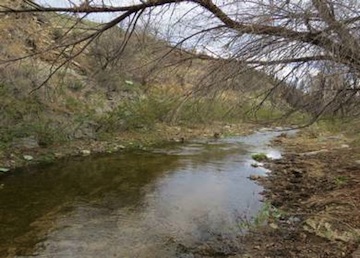| Entertainment Magazine Treasures of the Santa Catalina Mountains The Canyon of Gold-Cañada del Oro
Photo of the Cañada del Oro during a wet season when the normally dry creek flows. Photo by Robert Zucker © 2014.The Cañada del Oro has been a consistant source of gold and mineral ore. [9] The Spanish name– Cañon de Oro– means the “Canyon of Gold.” This golden gulch sparked the Tucson gold rush in the mid-1850s. At different times, the creek was also called Canyon del Oro and Gold Canyon Creek. [10] After rare summer and winter storms, the runoff flows out of the Santa Catalina Mountains from the north, runs past historic properties at the delta and turns to the south past ancient Indian ruins in the Catalina State Park. After the Cañada del Oro drains out the Santa Catalina Mountains, it empties into the Tucson valley, eventually joining the Santa Cruz River near Tucson and Marana at the I-10 Interstate. When it flowed regularly, it was a reliable source of life for both animals and humans. Mountain runoff still helps supply drinking water for northwest Tucson residents today. [11] Sightings of free flowing gold and other mineral veins stimulated most of the early American mining activity in this area. The Cañada del Oro has long history of Indian aggressions and gold discoveries. This was the first area of the Santa Catalina Mountains reported to contain valuable minerals. Even before American settlers began to arrive in Southern Arizona in the mid-1850s, they read newspaper stories about the Canyon of Gold near Tucson. As the Mexicans and Spanish explorers before them, prospectors found free flowing gold along the river and embedded in quartz veins. The hostile Apache Indians would repel many of those efforts to prospect for gold or to even pass through the area. Yet, tales about a sealed off lost gold mine, an abandoned mission with a hidden cache of buried treasure, and naturally occurring gold deposits, still drove the bravest into the hills. According to the legends, that mine, and the mission, may still be somewhere near the Cañada del Oro.
[1] “Mineral Appraisal of Coronado National Forest, Part 5.” U.S. Department of the Interior, Bureau of Mines, MLA 25-94, 1994. Page 24. [2] Also spelled as Charaleau. [3] “Tucson Census,” Education and Outreach, Arizona History Society. [4] Based on $1,340 value of gold in 2013. Gold values remained a constant $18.93 starting in 1993 a troy ounce through 1871 when it had increased a penny and continued to fluctuate a few pennies each year throughout most of the 1880-1890s. Source: Prices from 1883-1994, World Gold Council, from Timothy Green’s “Historical Gold Price Table.” [5] “Mineral Appraisal of Coronado National Forest, Part 5” 1994, page 25 [6] ibid, page 25 [7] ibid, pages 12-14 [8] “Mineral Appraisal of Coronado National Forest, Part 5.” Page 25. Reprinted 1983. S. Department of the Interior, Bureau of Mines, MLA 25-94, 1994. [9] Mining claims in the Cañada del Oro date back into the 1870s, but prospecting had been conducted for centuries. “Arizona Bureau of Mines Bulletin,” No. 132 (1932), “Arizona Gold Placers and Placering,” pages 59-61; “Arizona Bureau of Mines Bulletin,” No. 142 (1937); “Arizona Gold Placers and Placering,” pages 74-77; “Gold Placers and Placering in Arizona,” by E.D. Wilson, page 61. 1978; and the Arizona Department of Mineral Resources Gold Channel placer, #1T036 file. Cañada del Oro Mine (Old Hat placers; Gold Canyon placers; Gold Channel Placer #1-3), in the Cañada del Oro Wash, Oracle District (Control District; Old Hat District; Santa Catalina District), Santa Catalina Mts, Pinal and Pima Counties, Arizona, USA (mindat.org). [10] Gold Canyon Creek is cited in the “Official Map of the Territory of Arizona, compiled from Surveys, Reconnaissances and other sources, by E.A. Eckhoff and P. Riecker, Civil Engineers, 1880.” From the David Ramsey Collection, Cartography Associates. Publisher, The Graphic Co., Photo-Lith. NY. [11] “2013 Water Quality Report,” Metro Main Service Area, Metro Water District, Marana, Tucson. May 2014. Page 1. Buy "Treasures of the Santa Catalina Mountains"Print: Treasures of the Santa Catalina Mountains Kindle: Treasures of the Santa Catalina Mountains: Unraveling the Legends and History Email author and publisher: publisher@emol.org Treasures of the Santa Catalina MountainsEntertainment Magazine© 2015-2023 Entertainment Magazine. All rights reserved. |
